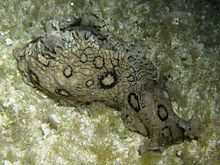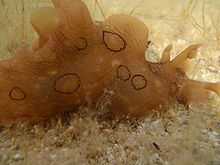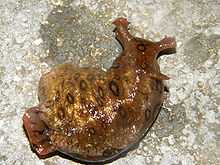Aplysia dactylomela
| Aplysia dactylomela | |
|---|---|
 | |
| Aplysia dactylomela | |
| Scientific classification | |
| Kingdom: | Animalia |
| Phylum: | Mollusca |
| Class: | Gastropoda |
| (unranked): | clade Heterobranchia clade Euthyneura clade Euopisthobranchia clade Aplysiomorpha |
| Superfamily: | Aplysioidea |
| Family: | Aplysiidae |
| Genus: | Aplysia |
| Species: | A. dactylomela |
| Binomial name | |
| Aplysia dactylomela (Rang, 1828) | |
Aplysia dactylomela, common name the "spotted sea hare", is a species of large sea slug, a marine opisthobranch gastropod mollusc in the family Aplysiidae, the sea hares. [1]
Distribution
This species of sea hare is cosmopolitan, being found in almost all tropical and temperate seas, including recently the Mediterranean Sea.
Description


The colour of the spotted sea hare is very variable, from pale gray to green, to dark brown. There are almost always large black rings on the mantle.
The maximum recorded length is 410 mm.[2]
Habitat
Aplysia dactylomela is commonly found in shallow waters, tide pools and rocky and sandy substrates, they also will be found feeding in beds of sea grass. During the day they will mostly hide under large rocks and in crevices. They usually stay in relatively shallow water, but they have been found as deep as 40 m.[3]
Minimum recorded depth is 0 m.[2] Maximum recorded depth is 3 m.[2]
Human use
The right giant neuron of Aplysia dactylomela, which is found in the abdominal ganglion, is similar to that of vertebrates, meaning it is ideal for the study of electrophysiology, as well as conditioned-response studies. These neurons have been found to be invaluable in neurological research; the reason for this is that long-lasting effects in neuronal behavior can be detected.[4]
Behaviour
The Aplsia dactylomela is capable of swimming and crawling. It accomplishes the former by creating a funnel using the parapodia folded forward and downwards; this action pulls in water. It then pushes the water out from behind the animal by pressing the anterior parts of the parapodia together, thus forward motion is achieved.
The sea hare's usual mode of propulsion is crawling; it crawls by lifting the front end of the foot, stretching it forward then placing it on the ground in front, creating an arching pattern; the remainder of the body follows this arching pattern until the tail is reached.[5]
Defense
Like the octopus, the Aplysia dactylomela squirts purple ink if it is disturbed; this ink is an irritant that causes 'altered behaviour' in other invertebrates and fish.[6] Their leathery skin contains toxins which make this sea hare practically inedible to most predators.[7]
References
- ↑ Gofas, S. (2012). Aplysia dactylomela Rang, 1828. Accessed through: World Register of Marine Species at http://www.marinespecies.org/aphia.php?p=taxdetails&id=138753 on 2012-03-31
- ↑ 2.0 2.1 2.2 Welch J. J. (2010). "The "Island Rule" and Deep-Sea Gastropods: Re-Examining the Evidence". PLoS ONE 5(1): e8776. doi:10.1371/journal.pone.0008776.
- ↑ Sterrer, Wolfgang. 1986. Marine Fauna and Flora of Bermuda. A Wiley-Interscience Publication.
- ↑ Corning, W., J. Dyal. 1973. Invertebrate Learning: Volume 2. New York: Plenum Press.
- ↑ http://animaldiversity.ummz.umich.edu/site/accounts/information/Aplysia_dactylomela.html
- ↑ Carefoot, T.H, S.C. Pennings, Jean Paul Danko. 1999. A test of novel function(s) for the ink of sea hares. J. Exp. Mar. Bio. Ecol. 234 (2):185.
- ↑ http://www.thecephalopodpage.org/MarineInvertebrateZoology/Aplysiadactylomela.html
- Bebbington A. (1974) Aplysiid species from East Africa with notes on the Indian Ocean Aplysiomorpha (Gastropoda: Opisthobranchia). Zoological Journal of the Linnean Society 54(1): 63-99
- Bebbington A. (1977) Aplysiid species from Eastern Australia with notes on the Pacific Ocean Aplysiomorpha (Gastropoda, Opisthobranchia). Transactions of the Zoological Society of London 34: 87-147.
- Rosenberg, G. 1992. Encyclopedia of Seashells. Dorset: New York. 224 pp. page(s): 118
- Richmond, M. (Ed.) (1997). A guide to the seashores of Eastern Africa and the Western Indian Ocean islands. Sida/Department for Research Cooperation, SAREC: Stockholm, Sweden. ISBN 91-630-4594-X. 448 pp.
- Gofas, S.; Le Renard, J.; Bouchet, P. (2001). Mollusca, in: Costello, M.J. et al. (Ed.) (2001). European register of marine species: a check-list of the marine species in Europe and a bibliography of guides to their identification. Collection Patrimoines Naturels, 50: pp. 180-213
- Branch, G.M. et al. (2002). Two Oceans. 5th impression. David Philip, Cate Town & Johannesburg
- Rolán E., 2005. Malacological Fauna From The Cape Verde Archipelago. Part 1, Polyplacophora and Gastropoda
- Rosenberg, G., F. Moretzsohn, and E. F. García. 2009. Gastropoda (Mollusca) of the Gulf of Mexico, Pp. 579–699 in Felder, D.L. and D.K. Camp (eds.), Gulf of Mexico–Origins, Waters, and Biota. Biodiversity. Texas A&M Press, College Station, Texas
External links
| Wikimedia Commons has media related to Aplysia dactylomela. |